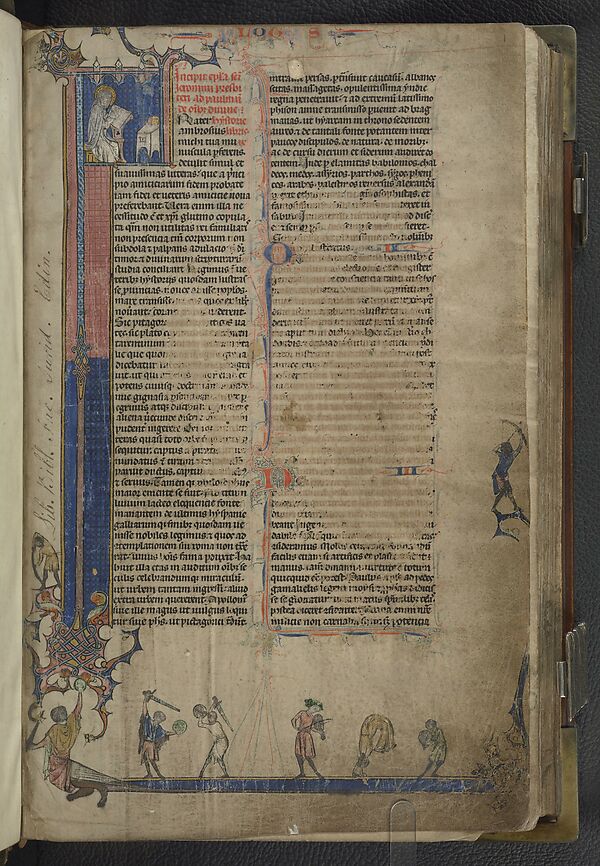Illuminated manuscripts.
Subject
Subject Source: Art & Architecture Thesaurus
Scope Note: Handwritten manuscripts that have been decorated with gold or silver, brilliant colors, designs, or miniature pictures. Although prevalent in Islamic and Asian societies, the longest tradition of illuminating manuscripts was in Christian medieval Europe, from the 6th-16th centuries, when the art was superseded by printed illustrations. Generally, the manuscripts were both 'historiated', or decorated with relevant paintings, and 'illuminated' in its original sense, meaning decorated with calligraphic initial capital letters using gold leaf. Over time, the term 'illuminated' came to refer to any illustration or decoration in a manuscript. Illuminated manuscripts played a major role in the development of art, partly because of the manuscript's portability in carrying artistic developments from one region to another.
Found in 106 Collections and/or Records:
Records of Saint Ninian`s Cathedral, Perth; of the diocese of St Andrews, Dunkeld, and Dunblane; and of the Episcopal Church in Scotland.
Fonds
Identifier: Dep.251
Scope and Contents
Also included are papers of clergymen connected with Saint Ninian`s, including sermons, historical and liturgical works by Bishop Charles Wordsworth, Bishop George Howard Wilkinson, Dean George Taylor Shillito Farquar, and Dean James Wilson Harper.
Dates:
1648-20th century.

'Ruskin Bible'.
Item
Identifier: Adv.MS.1.1.1
Scope and Contents
The manuscript, written in Northern France, takes its name from John Ruskin who greatly admired it (`The Works of John Ruskin`, edited by E T Cook and A Wedderburn (London, 1903-1912), volume xii, page 144). It is described in the exhibition catalogue `Treasures from Scottish Libraries` (Edinburgh, 1964), number 20.Sir John Sinclair’s `Statistical Account of Scotland, 1791-1799` (Wakefield, 1978), x, page 294 refers to a note with the manuscript which stated that it was used ‘in...
Dates:
2nd half of 13th century.
Sarum processional, 15th century.
Item
Identifier: Adv.MS.18.5.20
Scope and Contents
15th-century processional produced in England. The manuscript contains musical services according to the Use of Sarum. The work is written in littera textualis with 24 lines to a page.The contents are as follows:Temporale. Folios 1r-143v.Sanctorale. Folios 144r-176v.Commune Sanctorum and Votive. Folios 176v-193v. Folio 1r is extensively decorated and features two illuminated initials and a complete border. The initials are blue and...
Dates:
15th century.
Sermones de Tempore, a homiliary written in the early 12th century for Rochester Cathedral Priory.
Item
Identifier: Adv.MS.18.2.4
Scope and Contents
The book is in the tradition of the homiliary compiled by Paulus Diaconus at the command of Charlemagne (see ‘Homéliaires liturgiques médiévaux’, chapter XIII), with additions for the weekdays after Pentecost and the Nativity, and a few other alterations (some of these are shared with the version of Paulus printed in ‘Patrologia Latina’, 95, others with contemporary English homiliaries, cf. `Texts and their traditions in the medieval library of Rochester Cathedral Priory`, chapter IV). ...
Dates:
Early 12th century.
Theological works written in Germany.
File
Identifier: MS.9741
Scope and Contents
The contents are as follows.(i) Abbreviations of the Sentences of Peter Lombard in four books – Friedrich Stegmülller, ‘Repertorium commentariorum in Sententias Petri Lombardi’ (Würzburg, 1947), number 9. Ends 'Et videbunt cadavera virorum etc piitet unusquisque deo gratias etc est finis'. (Folio 1.)(ii) Albertus Magnus, 'Quaestiones super missus est', or 'De laudibus beatae Mariae Virginis' – Stegmüller, ‘Repertorium biblicum medii aevi’, (Madrid, 1940-) number 1061....
Dates:
15th century.
